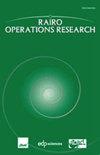Modelling the forest harvesting tour problem
IF 1.8
4区 管理学
Q3 OPERATIONS RESEARCH & MANAGEMENT SCIENCE
引用次数: 0
Abstract
In a globalized market, forest management plans play an important role in the sustainability of forest enterprises. Several optimization processes have therefore been developed to support decision-making in forestry operations. However, important issues remain to be addressed, such as planning the allocation of harvesting areas and scheduling the harvesting teams that are contracted for these purposes. Harvesting schedules include different time scales and natural constraints, so that finding optimal or even good quality ones constitutes a highly complex combinatorial optimization problem. Efficient planning of harvesting operations can significantly reduce the costs associated with logistics and improve the economic performance of companies in the sector. In Uruguay, almost 75\% of total forest harvesting operations for pulp production are carried out by contractor companies, so they are an important player in the supply chain. This study aims to optimize the allocation and routing of the harvesting equipment of forest contractors, which must be located at the sites to be harvested during the year. Numerical experiments over a case study based on realistic data have shown that realistic-sized instances can be resolved by standard mathematical programming software in a reasonable time. The mathematical programming model can also be useful to evaluate potential gains in joint planning by several contractors with respect to the costs incurred by separate planning; as illustrated also with numerical examples over the same case study. This model can be used to support annual forest harvest scheduling and equipment allocation for corporate contractors, leading to better quality plans and improvement opportunities.森林采伐旅游问题的建模
在全球化市场中,森林经营计划对森林企业的可持续性起着重要作用。因此,制定了若干优化程序,以支持林业业务的决策。然而,一些重要的问题仍有待解决,例如规划采收区域的分配和为这些目的而签约的采收小组的日程安排。收获计划包括不同的时间尺度和自然约束,因此寻找最优的甚至是高质量的收获计划构成了一个高度复杂的组合优化问题。有效的采收作业计划可以显著降低与物流相关的成本,并提高该行业公司的经济绩效。在乌拉圭,近75%的纸浆生产森林采伐作业是由承包商公司进行的,因此它们是供应链中的重要参与者。本研究旨在优化森林承包商采伐设备的配置和路线,这些设备必须位于全年的采伐地点。基于实际数据的数值实验表明,标准数学规划软件可以在合理的时间内解决实际尺寸的实例。数学规划模型也可用于评价由几个承包商就单独规划所引起的费用进行联合规划的潜在收益;在相同的案例研究中也用数值例子说明了这一点。该模型可用于支持企业承包商的年度森林采伐计划和设备分配,从而提供更好的质量计划和改进机会。
本文章由计算机程序翻译,如有差异,请以英文原文为准。
求助全文
约1分钟内获得全文
求助全文
来源期刊

Rairo-Operations Research
管理科学-运筹学与管理科学
CiteScore
3.60
自引率
22.20%
发文量
206
审稿时长
>12 weeks
期刊介绍:
RAIRO-Operations Research is an international journal devoted to high-level pure and applied research on all aspects of operations research. All papers published in RAIRO-Operations Research are critically refereed according to international standards. Any paper will either be accepted (possibly with minor revisions) either submitted to another evaluation (after a major revision) or rejected. Every effort will be made by the Editorial Board to ensure a first answer concerning a submitted paper within three months, and a final decision in a period of time not exceeding six months.
 求助内容:
求助内容: 应助结果提醒方式:
应助结果提醒方式:


